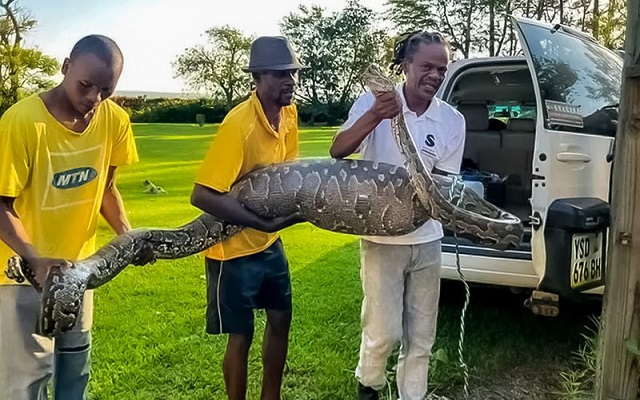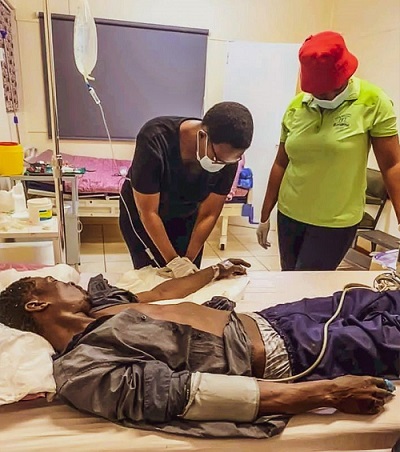
Eswatini is facing a critical shortage of antivenom to treat the numerous victims of snake bites in the country. The woman founder of the country’s antivenom foundation has a solution.
SPECIAL FEATURE | BIRD AGENCY | While collecting firewood in a remote forest in Lubombo, eastern Eswatini, a deadly black mamba snake bit 29-year-old Cindy on her lower thigh.
As she screamed in pain back in her village, someone from the neighbouring homestead quickly brought a concoction for her to drink. Desperate, she drank the bitter contents before a friend rushed her to the hospital.
Thea Litschka, Eswatini’s only woman snake handler and founder of the Eswatini Antivenom Foundation, was on duty at the hospital that day and recalled that Cindy (whose surname has been withheld) was brought in with classic black mamba symptoms: sweating, restlessness, nausea, and respiratory distress. However, there was also blood in her vomit.
The team attending to Cindy thought it had made a mistake with the diagnosis, Litschka explained, because black mamba snakebite victims do not bleed profusely internally.
“She was coughing up blood and when she vomited, it was bright red. Her abdomen was swelling rapidly – something was very, very wrong,” she said.
A referral was quickly arranged to The Luke Commission (TLC), which still had antivenom and life support critical for advanced black mamba bites.
“We asked her friend if she had taken a home remedy. She said no. Blood units were immediately given. She was also given a large dose of anti-venom, but her condition continued to deteriorate,” Litschka recalled.
Shortly after that, Cindy’s heart stopped, and a little later, she was declared dead.
“We finally discovered that the concoction she drank was so corrosive that it had destroyed her stomach and intestines, which was the cause of the bleeding. She didn’t die from the snakebite but from the concoction, a supposed traditional snakebite cure.”
Cindy’s case is one of the numerous daily cases that Litschka has handled. Her work in snake conservation and education dates back to 2005.
Recently, however, Litschka’s work has been jeopardised by an unexpected development. The facility that produces anti-venom for many countries across Africa – South African Vaccine Producers – was been hit by nationwide power outages that crippled production. The unit is now desperately trying to recover its output, but deliveries outside the country have been badly affected.

“Anti-venom is an essential medicine without it, the victim will die or lose a limb. Not having anti-venom in Eswatini is beyond unacceptable. Unfortunately, the supplier from South Africa has let the entire southern African continent down. We can’t buy, even if we wanted to. They can’t supply. I am still waiting for stock we paid for in November 2021,” she said.
Litschka explained that the countrywide shortage of anti-venom means the Eswatini Anti-venom Foundation (EAF) volunteers are constantly on call, working with the clinicians from the hospitals and clinics to assess bites and, if necessary, transfer patients to TLC, the only facility that still has vials of anti-venom left.
“Despite receiving and treating 110 patients so far, they have never turned us away, and because every bite is carefully assessed and consulted, they have never run out of antivenom. YET!”
Moreover, anti-venom is currently very expensive and unaffordable for most people in Eswatini. The cost to treat one Mozambique spitting cobra victim is US$1620, and a black mamba bite is US$1080 – much more expensive than the average Swazi can afford.
So Litschka and her team at the EAF, who, she says were concerned about supplies as far back as 2016, pushed through and found funding to develop a product and to put it through pre-clinical testing.
“Sadly, it is taking quite long to get it registered and imported into Eswatini but we are hopeful that it will be in all the health centres and hospitals for the next snakebite season. The cost is also one-quarter of the price we are paying now, which will assist with the financial burden, not just for the Foundation, but also for the country,” she added.
In addition to this, Litschka and the EAF are currently involved in development research for antivenom that will be free to snakebite victims. This research entails studying snake venom to see if it changes in captivity.
“Companies who extract venom for the production of antivenom are not controlled. It is our suspicion that if you keep a snake in captivity for many years and only feed it dead food, the venom composition may change,” she stated.
The study is being conducted on 180 snakes some are fed dead food only, others only live mice and the third control group, a variety of live food as they would find in natural settings.
Several research projects have since been completed, and they are busy with a few more. Snakebite data from all the major health centres and hospitals in Eswatini was also collected.
A special data book captures data regarding the victim (age, occupation, region), what the victim did when they got bitten, the venom (syndrome) effects, if antivenom was used and the outcome.
“This helps us determine where we need antivenom. We have 15 antivenom banks throughout the country and where education is most needed. Then we put the data of snake rescued in the mix as well as habitat. We have developed a “Risk Map” together with the University of Eswatini that will help us plan better,” she added.
They have also conducted further studies to look into the effects of Mozambique spitting cobra venom and the effectiveness of the antivenom.
Snakebite assistants were stationed in all the hospitals, who called when a victim arrived and sent pictures.
“I would then tell them if the victims should be included in the study. We monitored the wounds, how big, blisters, blebs, etc. We have also studied the effectiveness of our new antivenom,” she said.
Litschka is confident that these efforts will soon bear fruit and casualties from snake bites will remain a thing of the past in Eswatini.
*****
SOURCE: Bird story agency
 The Independent Uganda: You get the Truth we Pay the Price
The Independent Uganda: You get the Truth we Pay the Price



At 24, Scott Collins was enjoying life to the fullest when he suddenly started experiencing headaches and blacking out.The
young cook from Mount Gambier, , would often have migraines so
severe he would vomit in the middle of the night.After seeing six different doctors
who thought the symptoms were due to stress or a sinus infection, one physician insisted he had an MRI – which found a brain tumour the size of a grapefruit.’I was
practically on my deathbed but didn’t even realise it; the
tumour was pushing my brain into my skull and causing the headaches,’ Scott told Daily Mail Australia.Within an hour of having the MRI he was flown to
the Royal Adelaide Hospital for surgery in November 2017.
Scott Collins (pictured, left) experienced extreme headaches and migraine for two months before doctors found a
tumour the size of a grapefruit growing in his brain in 2017 ‘I was practically
on my deathbed but didn’t even realise it; the tumour was pushing my brain into
my skull and causing the headaches,’ Scott told Daily Mail Australia. Within an hour of having the MRI he was flown to the Royal Adelaide
Hospital for surgery in November 2017Scott,
now 29, recalled having ongoing symptoms for two months and felt
frustrated being turned away by doctors.The tumour was located on his right frontal lobe, which plays a vital role in regulating emotions, likely causing a change in Scott’s behaviour as he seemed ‘short-tempered’ towards others.’During the MRI there were about five doctors looking at the computer screen and
afterwards one of them said: “We don’t know how you’re still alive”,’ Scott said. Shortly after he had
surgery which ‘went well’ but doctors couldn’t remove the entirety of the tumour due to its location in the brain. Still to this day
doctors are unsure what caused the cancer as Scott has
no family history of disease. RELATED ARTICLES
Share this article Share 236 shares The
tumour was located on his right frontal lobe, which plays a
vital role in regulating emotionsAfter surgery
Scott returned to work to maintain a sense of normality, but two months
later in early 2018 he needed to return to the Mount Gambier hospital for another MRI.During his appointment
accompanied by his mum, he received the devastating news that the tumour had
returned as an aggressive stage 3 cancer that had moved to his
optical nerve. ‘It took me a minute or two to process what was
happening, then I just broke down in tears,’
he said. ‘You would never wish this upon anyone; I had moments
of doubt but managed to stay positive through it.’Seeing the look on mum’s face was absolutely
devastating.’ Scott was given two options moving forward
– to either operate with a high risk of becoming
paralysed from nerve damage or own the chemotherapy route.
Scott returned to work to maintain a sense of normality, but two months later in early 2018 he needed to return to the Mount Gambier hospital
for another MRI. During his appointment he received the devastating news that the tumour had returned as
an aggressive stage 3 cancer Scott was given two options moving forward – to either
operate with a high risk of becoming paralysed from nerve damage or own the chemotherapy route.
He chose to have treatmentScott first started radiotherapy which continued for eight weeks
followed by chemotherapy. He had side effects including nausea, vomiting and weight loss but didn’t
lose his hair. ‘I had one of the most potent doses of chemo you
could possibly get which left me unwell and in hospital and I
only got through four of the eight rounds,’ he said.During treatment
he stayed at at either the Greenhill Cancer Council Lodge or with family in Adelaide. After the fourth dose of chemotherapy he decided to return home and drove himself to Mount
Gambier, but due to treatment he kept vomiting for most of the drive.He returned to work but felt extremely fatigued and
almost passed out on multiple occasions, leading him to quit to focus on his health. Scott also attempted boosting his fitness levels by
going to the gym and playing field hockey but during his second match he collapsed on the field. ‘I thought I was having a heart attack and was taken to hospital,’
he said. Eight months ago Scott married
the love of his life and is now the stepfather of two adorable young children
As of June 17, 2020 Scott has been in remission and continues to monitor his health through MRI checkups every six monthsAs of June 17,
2020 Scott has been in remission and continues to monitor his health
through MRI checkups every six months. Consequently he’s been left with health issues that impact his lifestyle, including poor vision and fatigue. Eight months ago Scott married the
love of his life and is now the stepfather of two adorable young children.He encourages those going
through cancer treatment to think positive and always get a second opinion from
doctors.<div class="art-ins mol-factbox femail" data-version="2" id="mol-9796c7b0-d176-11ec-9afc-1b61ee23f1fb" website diagnosed with brain cancer at 24 after suffering from headaches